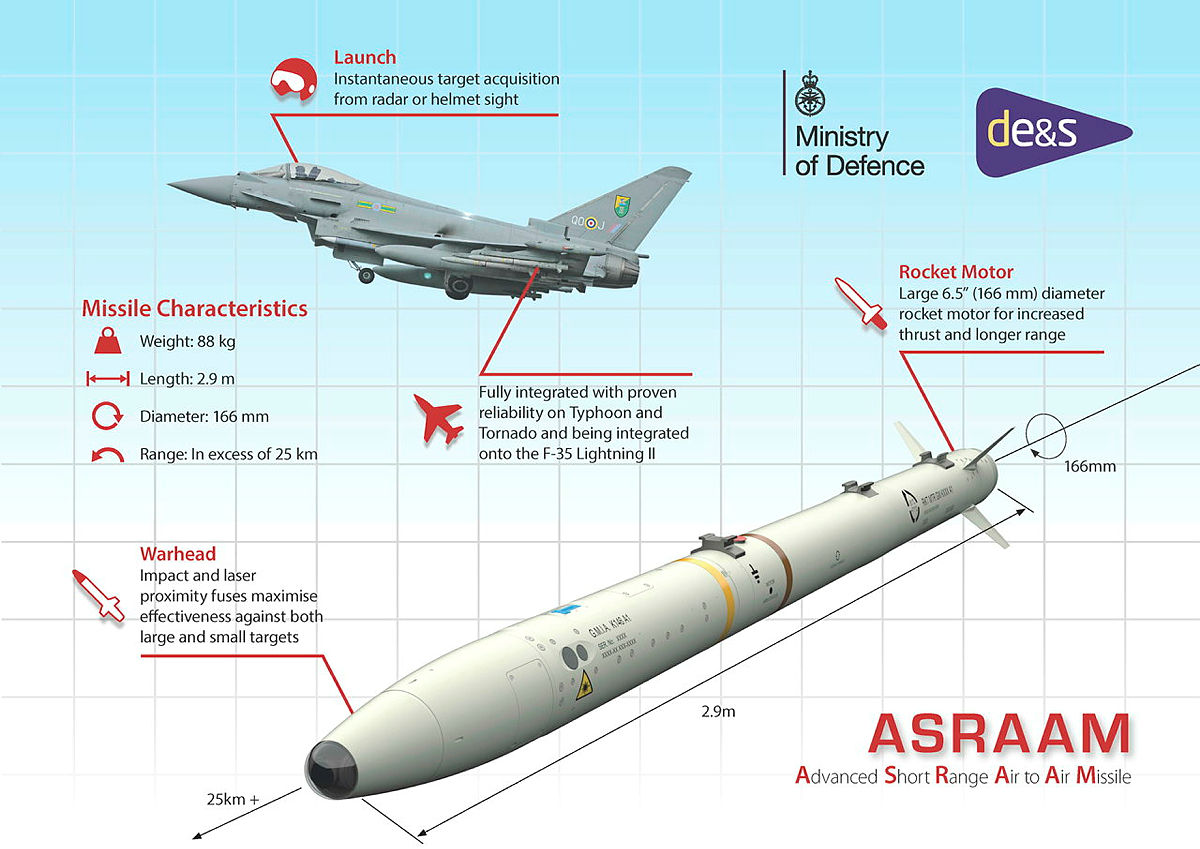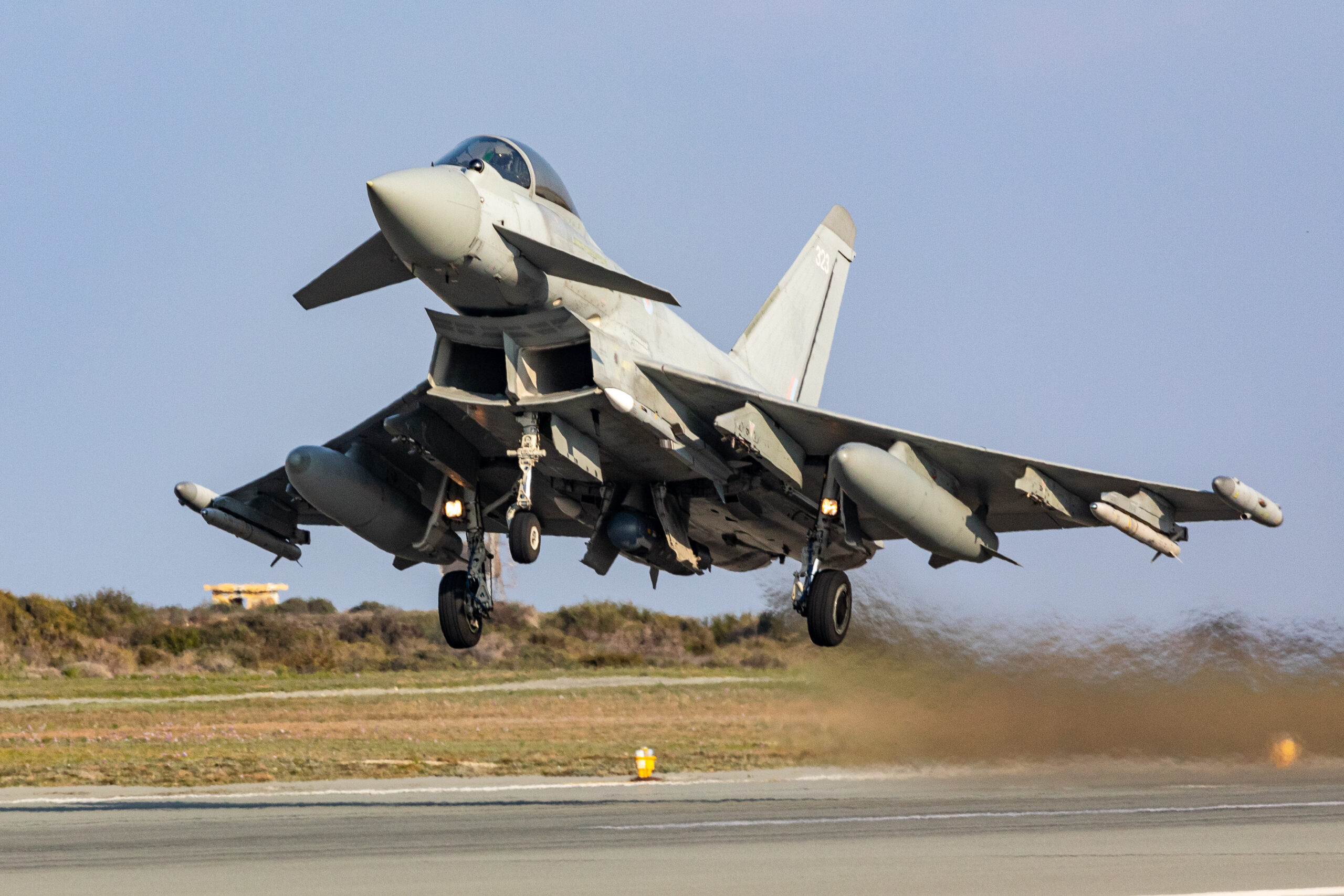The U.K. Royal Air Force, or RAF, has provided details of a major live-fire exercise that saw the largest-ever number of Advanced Short Range Air-to-Air Missiles, or ASRAAMs, launched against target drones. In all, 53 of the missiles were fired over a 10-day period, by pilots from multiple RAF squadrons flying an undisclosed number of Typhoon multirole fighters and F-35B stealth fighters. Each of those missiles reportedly costs around £200,000 (or approximately $225,500 based on the current conversion rate).
Broadly similar to the U.S. Weapons System Evaluation Program, or WSEP, the Missile Practice Camp took place over the sea in the Hebrides Air Weapon Ranges, off the northwest coast of Scotland, last month. In all, the ranges cover some 44,000 square miles of airspace with unlimited altitude. The live-fire drill, apparently named Exercise FOX2 Frenzy, in reference to the brevity code for an infrared-guided missile launch, exclusively involved the ASRAAM, a weapon produced by the pan-European MBDA missile house.

The fighter jets were drawn from no fewer than eight squadrons, including the two U.K.-based F-35B squadrons, No. 207 and No. 617 “Dambusters,” both based at RAF Marham, England, when not operating aboard the Queen Elizabeth class aircraft carriers.
From RAF Lossiemouth, also in Scotland, Typhoons came from all four of that base’s squadrons — No. 1 (F), No. II (AC), No. 6, and No. IX (B) — all of which have an operational role. The U.K.’s other Typhoon base, RAF Coningsby in England, participated in the shape of the frontline No. 3 (F) Squadron and No. 41 Test & Evaluation Squadron. The last of these is responsible for developing the Typhoon’s capability and tactics and was involved in a previous live-fire campaign off the Scottish coast last month, which saw a decommissioned U.S. Navy warship sunk by a variety of weapons.

In a press release, an unnamed weapons technician from No. IX (B) Squadron said: “Seeing the preparation of the aircraft and missiles was crucial to the more junior members on the squadron; it gave them the opportunity to understand the challenges of a live weapon firing exercise. Operating armed aircraft requires all those involved to maintain the highest levels of concentration due to the extra risks involved. As a weapons technician, you get massive job satisfaction when you’ve loaded the aircraft, carried out all the post-load testing, and watched it taxi away armed. When the aircraft returns ‘clean’ having successfully fired its missiles, it validates the years of training, the hard work and months of preparation.”
As for the ASRAAM, this is the standard short-range air-to-air missile for the British Typhoon and F-35B. Each one of these missiles weighs a little under 200 pounds, is 9 feet 6 inches long, and has a diameter of 6.5 inches. The missile has an imaging infrared seeker that can acquire targets autonomously, or the missile can receive target data from aircraft sensors, including the radar or helmet-mounted sight. ASRAAM has a high off-boresight capability, or HOBS, for close-in dogfighting. However, targets can reportedly be engaged at a distance of more than 15 miles; unconfirmed accounts assess the range is much greater than this, perhaps as far as 31 miles. This almost puts the weapon in the medium-range class, something that the U.S. AIM-9X Sidewinder increasingly seems to be working toward.

The ASRAAM, which is in the same generation as the AIM-9X Sidewinder and the European IRIS-T, is noted for its very high speed — a factor that’s clear to see as it races off the launch rail in videos from the Missile Practice Camp. Thanks to a rocket motor that’s very powerful for its size, the ASRAAM can reportedly exceed Mach 3, which also translates to particularly long-range for a weapon in its class. The tradeoff is somewhat reduced agility at closer ranges, compared to other short-range AAMs.

“It surpassed all expectations of what my first live firing exercise on the Typhoon would be,” said one unnamed Typhoon pilot from RAF Lossiemouth. “Selecting the weapon and knowing a live missile would come off the rail was a unique moment; hearing the missile tone and pulling the trigger, followed by a large whoosh sound and a slight wobble of the aircraft was fantastic. Watching the missile disappear into the sky in front of me was a moment to remember, it really is impressive how fast the Advanced Short Range Air-to-Air Missiles can go. The experience has given me a real appreciation of the capability of the missile and how it can be employed in a real combat situation.”
For many years, the ASRAAM saw service with only the U.K. Royal Air Force and Royal Australian Air Force (RAAF). The latter has now retired the missile, along with its F/A-18A/B Hornets, although, more recently, it has also been acquired by Oman and Qatar, to arm their Typhoons. Furthermore, India has selected the missile to arm its Jaguars and plans to add it to its Su-30MKI Flankers, providing at least a partial replacement for the Russian-made R-73 (AA-11 Archer).
Improvements have continued to be made to the ASRAAM during its production life, with the latest model procured by the U.K. Ministry of Defense being the Block 6. This entered service on the RAF’s Typhoons earlier this year and is planned to be integrated onto the F-35B in 2024.

The Block 6 missile introduces a number of improvements including an improved U.K.-designed infrared seeker and a built-in cryogenic cooling system. At the same time, the replacement of American-made components with new British-made ones ensures it is not covered by the U.S. International Traffic in Arms Regulations (ITAR), which should ease export to a wider number of countries.
The ASRAAM saw its first combat use in December last year when an RAF Typhoon shot down a hostile drone over Syria. This was also the first confirmed air-to-air engagement for the Typhoon in British service. Remarkably, it was seemingly also the first time since the late 1940s that an RAF pilot, flying an RAF plane, had shot down an enemy aircraft of any kind in aerial combat.

With only limited exposure to combat so far, the ASRAAM and other air-launched weapons require repeated testing, in realistic environments, including full end-to-end engagements such as during the Missile Practice Camp. These kinds of exercises provide aircrew and maintainers with invaluable experience, all the way from handling and loading live missiles onto the jets to working alongside other personnel and assets from around the service. Critically, for some of the pilots at least, this was the first time they had ever launched an ASRAAM. Finally, firing off a batch of missiles will ensure that the inventory is useable.
Then there is the technical aspect, of assessing the reliability and capability of the ASRAAM to actually destroy multiple aerial targets, aided by the Hebrides Air Weapon Ranges’ fully instrumented 3D test and evaluation equipment that gathers real-time data on missile launches. In this case, the targets were Banshee drones that can be used to replicate hostile manned aircraft and UAVs. A variant of the same drone design is also being used by the U.K. Royal Navy to help develop future carrier-based UAV concepts, beginning with threat replication.

The availability of such a large number of ASRAAMs to be expended in a training environment was due to these missiles being almost time-expired, according to a tweet from Group Captain Phil Marr, who heads up the U.K.’s Lightning Force, responsible for F-35B operations.
Each missile round has a ‘shelf life’ of a certain number of years, after which they are judged no longer fully reliable. This indicates that earlier-batch ASRAAMs were expended in the Missile Practice Camp, disposing of them while also providing valuable training.
Interestingly, the U.S. Air Force, too, has recently racked up a record-breaking live-fire air-to-air missile exercise, involving its F-22 Raptor stealth fighters. In an exercise in September, the 1st Fighter Wing, at Joint Base Langley-Eustis, Virginia, loaded and successfully fired 28 AAMs on its F-22s during a two-week Weapons System Evaluation Program at Tyndall Air Force Base, Florida. Together, those missiles were valued at more than $14 million, according to the Air Force.

While we don’t know what kinds of threats the Banshee drones were replicating during the Missile Practice Camp, it’s noteworthy that the announcement of the live-fire exercise comes soon after Typhoons began to play a more active role in the Black Sea region, where tensions with Russia are running high.
After a Russian Su-27 Flanker fighter jet “released” a missile during an encounter with an RAF RC-135W Rivet Joint electronic surveillance aircraft, in an incident announced last week, these spy planes are now escorted by Typhoons while operating over the Black Sea. You can read more about the incident here. Suffice to say, live ASRAAM missiles are part of the standard RAF Typhoon weapons load for missions like these.
Meanwhile, the fact that different kinds of small unmanned aerial vehicles are a growing threat in various different theaters is increasingly apparent, and it’s no coincidence that the first confirmed aerial kill for ASRAAM was a drone.
Like Saudi Arabia in the past, which has used Typhoons and other fighter jets to tackle Houthi drones (and cruise missiles), now Ukraine is also being forced to use similar tactics to confront the menace of kamikaze drones. Here, the developing air war is seeing Ukrainian fighter jets increasingly pushed into service as drone-hunters, tasked to intercept and shoot down relatively unsophisticated ‘kamikaze drones,’ namely the Iranian-supplied Shahed-136. Videos of Ukrainian warplanes giving chase to these drones, which have primarily targeted population centers and critical infrastructure, are indicative of the kind of mismatch in which missile-armed fighters or costly surface-to-air missiles are required to defeat these low-cost, yet potentially highly destructive weapons.
Whether knocking low- and slow-flying drones out of the sky or providing active defense to spy planes operating in potentially hazardous environments, it’s very clear that air-to-air missiles are as important as ever. Rigorous realistic testing like that provided in Missile Practice Camp should help ensure the RAF’s ASRAAM, and those who operate, are ready for whatever real-world threat they should face.
Contact the author: thomas@thedrive.com
